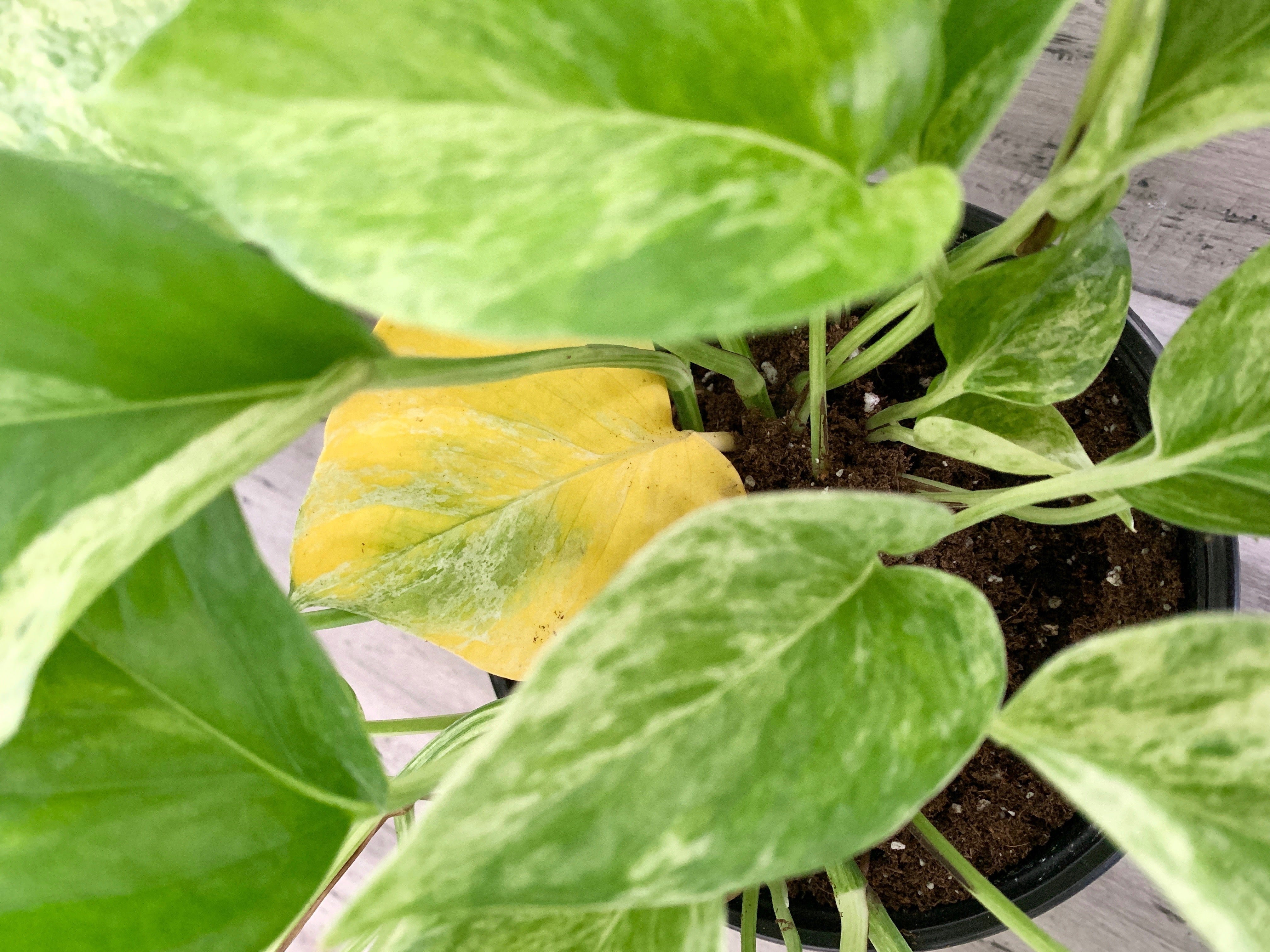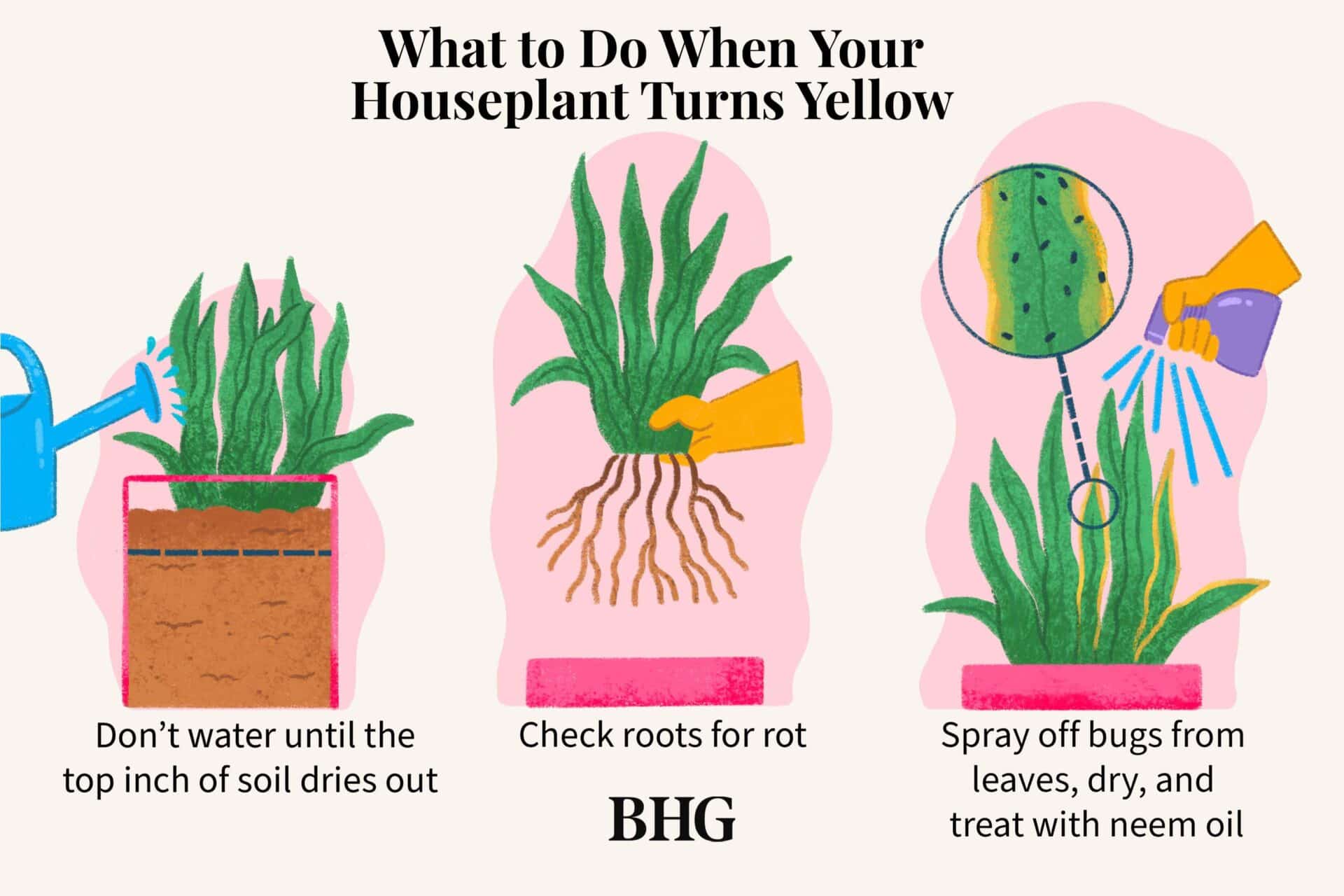When house plant leaves turn yellow, check for overwatering or underwatering. Ensure proper light and nutrient levels.
House plants add beauty and freshness to any home. Yellow leaves, however, can be a troubling sign. This discoloration often points to issues like incorrect watering, insufficient light, or nutrient deficiencies. Overwatering can suffocate roots, while underwatering can dry them out.
Both conditions stress the plant, leading to yellowing leaves. Lighting is also crucial; too much or too little can harm plant health. Nutrient imbalances or pests can also cause yellow leaves. Identifying the exact cause is essential for restoring your plant’s health. Regular monitoring and proper care can keep your house plants vibrant and thriving.
Common Causes
Yellowing leaves on house plants can be alarming. Identifying the cause is crucial. Several factors might be responsible for this issue. Understanding these causes helps in taking corrective measures.
Overwatering
Overwatering is a common cause of yellow leaves. Too much water suffocates the roots. This prevents the plant from absorbing nutrients. Signs of overwatering include soggy soil and mold growth. Ensure your pot has drainage holes. Water your plant only when the topsoil is dry.
Underwatering
Underwatering can also cause yellow leaves. Plants need water to stay healthy. Dry soil means the plant is thirsty. Check the soil moisture regularly. Water the plant if the soil feels dry. Use a moisture meter for accurate results.
Lack Of Light
Insufficient light can lead to yellow leaves. Plants need light for photosynthesis. Place your plant near a bright window. Rotate the plant for even light exposure. Consider using grow lights in darker rooms.
Nutrient Deficiency
Nutrient deficiency is another cause. Plants need nutrients to thrive. Yellow leaves may indicate a lack of essential nutrients. Use a balanced fertilizer. Follow the recommended dosage on the package. Consider a soil test to determine specific deficiencies.
| Cause | Signs | Solution |
|---|---|---|
| Overwatering | Soggy soil, mold | Water less frequently, ensure drainage |
| Underwatering | Dry soil, wilting | Water more regularly |
| Lack of Light | Pale, yellow leaves | Move to a brighter spot, use grow lights |
| Nutrient Deficiency | Yellow leaves, weak growth | Use balanced fertilizer |
Identifying The Problem
Yellow leaves on house plants can be a sign of trouble. It’s crucial to identify the problem early. This helps in saving your plant. Here’s how you can spot the issues:
Visual Signs
Yellow leaves are the most obvious sign. Look for these changes in color. Sometimes, you might see brown edges. Check for spots or patterns on the leaves. These can indicate pests or diseases.
Soil Check
Healthy soil is vital for plant health. Insert your finger about an inch deep into the soil. If it’s too dry, your plant may need water. If it’s soggy, you might be overwatering. Good soil should be moist but not wet.
Leaf Texture
Leaf texture can tell a lot about plant health. Crispy leaves often mean dryness. Soft or mushy leaves could signal overwatering. Feel the leaves gently. Healthy leaves should be firm and slightly flexible.
Watering Tips
Yellow leaves on house plants can be a worrying sign. Often, the issue lies in the way you water your plants. Proper watering techniques can prevent yellowing and keep your plants healthy. Below are some essential watering tips to help you care for your house plants.
Proper Technique
Using the right technique is vital for your house plants. Always water the soil directly. Avoid getting water on the leaves. Water slowly to let the soil absorb it. Ensure the water reaches the roots.
Use a watering can with a narrow spout. This helps you control the flow of water. A consistent watering routine keeps the soil evenly moist.
Frequency
Watering frequency depends on the plant type. Most house plants need water when the top inch of soil is dry. Stick your finger into the soil to check. Some plants need more frequent watering, like ferns.
Other plants, like succulents, need less frequent watering. Create a schedule to help you remember. Consistency is key to plant health.
Water Quality
Water quality affects plant health. Tap water often contains chemicals. These can harm your plants over time. Use filtered or distilled water if possible.
Rainwater is also a good choice. It contains natural nutrients. Test the water pH to ensure it is plant-friendly. Most house plants prefer a pH between 6.0 and 7.0.
| Plant Type | Watering Frequency | Water Quality |
|---|---|---|
| Ferns | Every 3-4 days | Filtered or rainwater |
| Succulents | Every 2-3 weeks | Distilled water |
| Tropical Plants | Once a week | Filtered or rainwater |
:strip_icc()/what-to-do-when-your-houseplant-leaves-turn-yellow-01-hero-ebc9272eed764c1ca830cdd18dc63f12.jpg)
Credit: www.bhg.com
Light Requirements
Understanding your house plant’s light requirements is essential. Yellow leaves often indicate improper lighting. Ensuring the right amount of light can revive your plants.
Natural Light
Natural light is vital for plant health. Place your plants near windows. Ensure they get enough sunlight without being scorched.
- East-facing windows: Morning sun is gentle and perfect.
- South-facing windows: Brightest light, ideal for most plants.
- West-facing windows: Afternoon sun, which can be too intense.
- North-facing windows: Low light, suitable for shade-loving plants.
Artificial Light
Artificial light can supplement natural light. Use it in dim rooms or during winter.
Two main types of artificial lights are:
- Fluorescent lights: Good for low-light plants. They are energy-efficient and affordable.
- LED lights: Ideal for all plants. They mimic natural sunlight and last longer.
Optimal Placement
Proper placement ensures your plant gets the light it needs. Follow these tips:
| Plant Type | Optimal Placement |
|---|---|
| Succulents | South or west-facing windows |
| Ferns | North or east-facing windows |
| Orchids | Filtered light from east or south-facing windows |
Monitor your plant’s reaction to light. Move them if leaves turn yellow.
Nutrient Management
Plants need proper nutrients to thrive. Yellow leaves often signal nutrient deficiencies. Managing nutrients is essential for healthy house plants. Let’s explore how to manage nutrients effectively.
Fertilizers
Fertilizers supply essential nutrients to plants. Choose the right type for your plant. Some common fertilizers include:
- Organic fertilizers like compost and worm castings.
- Inorganic fertilizers like liquid or granular formulations.
Apply fertilizers as per the instructions. Over-fertilizing can harm plants. Balance is key.
Soil Amendments
Soil amendments improve soil quality. They add nutrients and enhance soil structure. Common soil amendments include:
| Amendment | Benefits |
|---|---|
| Compost | Enriches soil with organic matter. |
| Perlite | Improves drainage and aeration. |
| Peat moss | Increases water retention. |
Mix amendments into the soil before planting. This ensures even distribution of nutrients.
Signs Of Deficiency
Yellow leaves indicate nutrient deficiency. Different deficiencies show specific signs:
- Nitrogen deficiency: Yellowing starts at the bottom leaves.
- Iron deficiency: New leaves turn yellow, but veins remain green.
- Magnesium deficiency: Yellowing between veins, starting on older leaves.
Identify the deficiency to choose the right treatment. Proper diagnosis is crucial for plant health.
Pest Control
Yellowing leaves can be a sign of pest infestation. Keeping your house plants healthy involves managing pests effectively. Learn how to identify and eliminate pests.
Common Pests
Several pests can cause yellowing leaves. Here are the most common ones:
- Aphids: Small, green or black insects that suck sap from plants.
- Spider Mites: Tiny spiders that leave webs on plants.
- Mealybugs: White, cotton-like insects found on stems and leaves.
- Scale Insects: Hard, brown bumps on stems and leaves.
Natural Remedies
Use natural remedies to control pests. They are safe for plants and pets.
- Neem Oil: Mix with water and spray on affected areas.
- Soap Solution: Mix mild soap with water and spray on pests.
- Alcohol Wipes: Use alcohol wipes to remove pests manually.
- Garlic Spray: Blend garlic with water and spray on plants.
Chemical Solutions
If natural remedies fail, consider chemical solutions. Use them carefully.
| Product | Usage | Precautions |
|---|---|---|
| Insecticidal Soap | Spray on affected areas. | Avoid using in direct sunlight. |
| Horticultural Oil | Apply to leaves and stems. | Do not use during hot weather. |
| Systemic Insecticides | Apply to soil or spray on plants. | Follow the label instructions carefully. |
Always follow the instructions on product labels. This ensures safe and effective use.
Repotting Advice
Repotting your house plant can be a crucial step when its leaves turn yellow. It helps refresh the soil, provide more space, and improve drainage. Follow these steps to ensure your plant thrives again.
When To Repot
You should repot your plant if you notice roots growing out of the drainage holes. Another sign is when the plant looks crowded and lacks space. Yellow leaves can also indicate the need for repotting. Aim to repot during the growing season, typically spring or early summer.
Choosing The Right Pot
Picking the correct pot is essential for your plant’s health. Select a pot that is one size larger than the current one. Ensure it has drainage holes to prevent waterlogging. Clay pots are a good choice for better air circulation.
Soil Types
The type of soil you use can impact your plant’s health. Choose a soil mix that matches your plant’s needs. Here are some common options:
- Succulents: Use a well-draining cactus mix.
- Ferns: Choose a peat-based mix for moisture retention.
- Orchids: Opt for a bark-based mix.
Make sure to refresh the soil every time you repot. This helps to provide new nutrients and a better growing environment.
:max_bytes(150000):strip_icc()/ms-why-houseplant-leaves-turn-yellow-eb9c9cdb05d54a2ba55e3542124ad193.jpg)
Credit: www.marthastewart.com
Preventive Measures
Yellow leaves on house plants can be alarming. Taking preventive measures ensures your plants stay vibrant. Below are key strategies to keep your plants healthy.
Routine Checks
Regular checks help identify issues early. Examine leaves and soil weekly. Look for pests, mold, or discoloration.
- Inspect leaves for yellow spots.
- Check soil moisture levels.
- Ensure proper drainage in pots.
Balanced Care
Balanced care is essential for healthy plants. Overwatering or underwatering can cause yellow leaves.
| Action | Frequency |
|---|---|
| Watering | Once a week |
| Fertilizing | Once a month |
| Pruning | Every 2-3 months |
Use a balanced fertilizer for nutrients. Ensure the plant gets enough light.
Seasonal Adjustments
Plants need different care in each season. Adjust watering and light exposure accordingly.
- Spring: Increase watering as plants grow.
- Summer: Provide more light and check for pests.
- Fall: Reduce watering and start pruning.
- Winter: Limit watering and ensure warmth.
By following these preventive measures, you can maintain healthy house plants. Consistent care ensures your plants thrive all year round.

Credit: outsideinco.com
Frequently Asked Questions
How To Fix Yellow Leaves On Indoor Plants?
To fix yellow leaves on indoor plants, ensure proper watering, provide adequate light, and check for pests. Trim affected leaves.
Should You Cut Yellow Leaves Off Houseplants?
Yes, cut yellow leaves off houseplants. Removing them improves plant health and appearance. Trim near the base carefully.
Can Plants Recover From Yellow Leaves?
Yes, plants can recover from yellow leaves. Identify the cause, adjust watering, provide proper nutrients, and ensure adequate sunlight.
Do Yellow Leaves Mean A Plant Is Overwatered?
Yellow leaves can indicate overwatering. Check soil moisture and ensure proper drainage to prevent root rot.
Conclusion
Yellow leaves on house plants are a common issue. Address the root cause to restore plant health. Regularly check for pests, proper watering, and sufficient light. With care and attention, your plants can thrive. Keep your green companions healthy and vibrant by following these tips.
Happy gardening!

My mission is to help you bring the beauty of nature indoors with expert advice, detailed plant care guides, and creative design ideas.





Leave a Reply